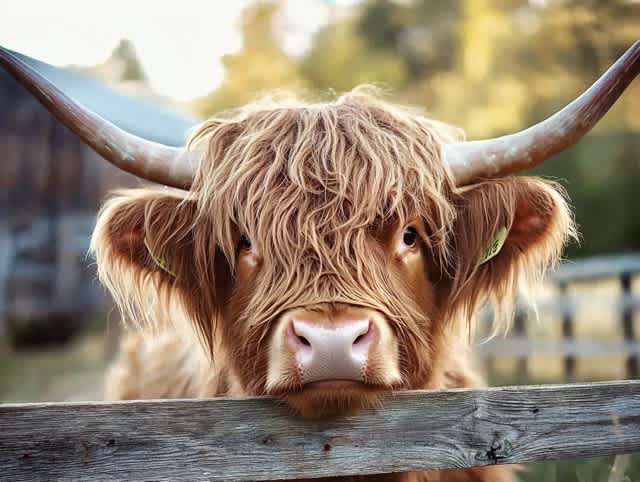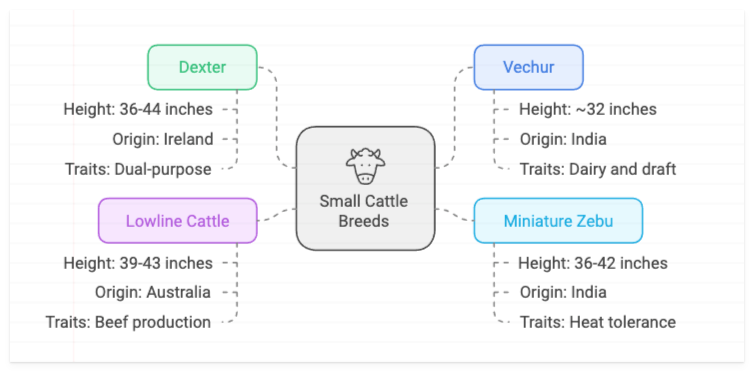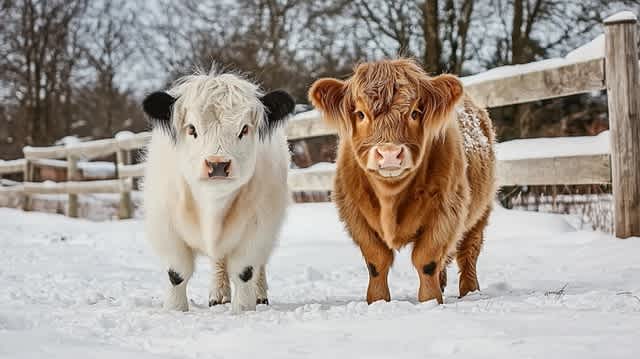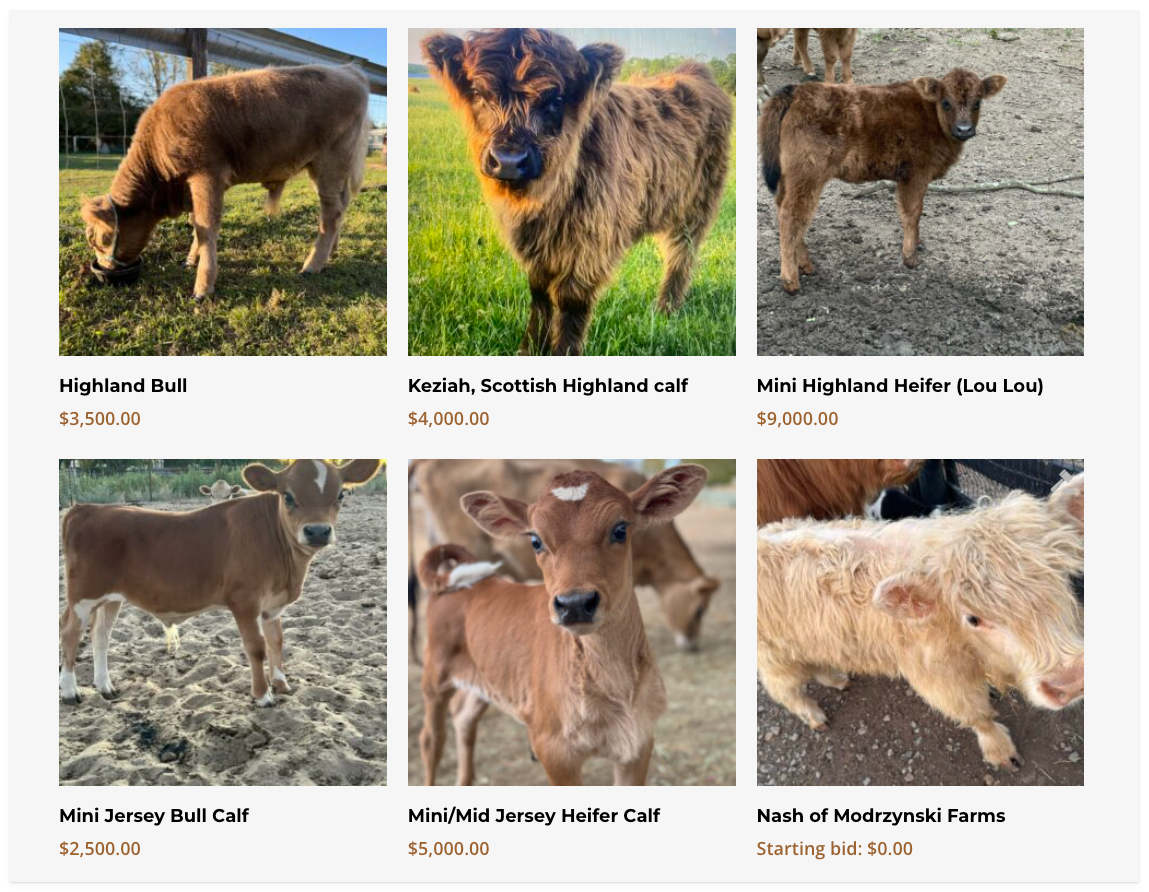The Truth About Teacup Mini Cows: A Guide for New Mini Cattle Farmers
Published: September 27, 2024

Call them mini cows, call them micro cows, just don't call them Teacup. As the popularity of mini cattle grows, so does the buzz around an even tinier variety: the "teacup mini cow." Social media is awash with images of these supposedly ultra-small bovines, promising the joy of cattle ownership in spaces no bigger than a backyard.
But what's the real story behind these diminutive dairy dreams? Are "teacup mini cows" a legitimate breed, a clever marketing ploy, or something in between?
In this guide, we'll explore the fascinating world of miniature cattle, separate fact from fiction, and provide essential insights for anyone considering adding these charming animals to their farm or homestead. Get ready to discover the big appeal of these small bovines.
Debunking the "Teacup Mini Cow" Myth
In recent years, social media has been littered with adorable images of incredibly tiny cows, often labeled as "teacup mini cows." These pint-sized bovines have captured the imagination of animal lovers worldwide. But as with many internet sensations, the reality behind "teacup mini cows" is more complex than it first appears.
Origin and Use of the Term
The term "teacup mini cow" seems to have emerged from the intersection of social media trends and creative marketing. It's likely inspired by the "teacup" designation used for extremely small dog breeds in the canine world. In the cattle industry, however, there's no official recognition of a "teacup" category.
Reality vs. Marketing Claims
While miniature cattle are indeed real and increasingly popular, the "teacup" label often attached to them can be misleading. Many of the claims surrounding these ultra-small cows don't stand up to scrutiny. Here’s what you can expect from a proper mini cow.
Size: Genuine miniature cattle are typically less than 48 inches in height.
Weight: Miniature cattle generally weigh between 200 to 500 pounds.
Care requirements: Even the smallest cattle require proper pasture, shelter, and care similar to their larger counterparts.
Milk production: Around 1.5 gallons of milk/day.
Smallest Recognized Miniature Cattle Breeds
While "teacup mini cows" may be more marketing hype than reality, there are several recognized breeds of miniature cattle that are quite small:
Dexter: Often considered one of the smallest cattle breeds, Dexters typically stand 36-44 inches at the shoulder.
Vechur: This rare breed from India is known for its small size, with cows standing around 32 inches tall.
Miniature Zebu: These small, heat-tolerant cattle usually measure between 36-42 inches at the shoulder.
Lowline Cattle: Developed from Angus cattle, Lowlines stand about 39-43 inches tall at the shoulder.
The "teacup mini cow" may be more of a digital-age myth than a barnyard reality, but the genuine miniature cattle breeds offer plenty of real-world appeal for small-scale farmers and homesteaders.

The Big Appeal of Little Cattle
Miniature cattle are making a big impact on small farms across the country. These pint-sized bovines, standing at roughly half the height of their full-sized counterparts, offer a compelling alternative for farmers with limited space or those looking to diversify their livestock.
Let’s see what the big deal is all about!
Space Efficiency
One of the most significant advantages of miniature cattle is their modest land requirement. While a standard cow typically needs 1-2 acres of pasture, mini cattle can do well on 1 acre. This space efficiency opens up cattle ownership possibilities for those with smaller properties or allows established farmers to increase their herd size without expanding their land.
Manageable Milk Production
For small-scale dairy enthusiasts, miniature cattle offer a more manageable milk production scale. Breeds like the Miniature Jersey can produce 1-2 gallons of milk daily, a far cry from the potentially overwhelming 6-7 gallons a standard dairy cow might produce. This makes mini cattle an excellent choice for families or small artisanal dairy operations.
Cost-Effective Feeding
The compact size of miniature cattle extends to their dietary needs. These small bovines typically consume about one-third to one-half the feed of standard cattle, potentially leading to significant cost savings over time. This reduced appetite isn't just good for the farmer's wallet - it's also gentler on the land, with mini cattle less likely to cause soil compaction or overgrazing.

Ease of Handling
Many farmers find miniature cattle easier to manage due to their smaller stature. This can be particularly advantageous during veterinary care, when moving animals, or for those new to cattle raising. Their generally calmer demeanor also makes them a good fit for families with children or for educational settings.
Now, with that said, these are still 800 pound animals, so they are no feather weights! Caution should always be practiced and children should never be left alone with them.
Comparing to Standard Cattle
While miniature cattle offer these benefits, it's important to understand they're not simply scaled-down versions of standard cattle:
Lifespan: Miniature cattle often have similar or slightly longer lifespans (15-20 years) compared to standard cattle.
Meat Production: Though they produce less meat per animal, the meat-to-feed ratio can be comparable to standard cattle.
Breeding: Mini cattle reach maturity at similar ages to standard cattle but may have slightly lower fertility rates in some breeds.
Hardiness: Many miniature breeds are known for their hardiness and adaptability, often matching or exceeding standard breeds in this regard.
While miniature cattle have many advantages, they're not necessarily easier to care for than standard cattle. They still require proper nutrition, regular veterinary care, and appropriate housing. The decision between miniature and standard cattle should be based on individual circumstances, goals, and resources.
Which brings is to our next section about how to best care for these animals.
Caring for Miniature Cattle (Space, Feeding, Health Requirements)
While miniature cattle require less space and resources than their full-sized counterparts, they still need proper care and management. Here's what potential mini cattle owners should know:

Pasture Needs
Miniature cattle typically require 1 acre of pasture per animal, depending on the quality of the land and available forage. Rotational grazing can help maintain pasture health and maximize land use.
Shelter Considerations
Despite their smaller size, mini cattle still need protection from extreme weather. A three-sided shelter that's at least 20 square feet per animal is generally sufficient. Ensure the shelter faces away from prevailing winds and provides adequate ventilation.
Types of Feed
Miniature cattle have similar nutritional needs to their larger cousins:
Pasture: High-quality grass should form the basis of their diet.
Hay: Provide good quality hay, especially during winter or when pasture is limited.
Grain: Some mini cattle may need supplemental grain, particularly if pregnant or lactating.
Minerals: Offer free-choice mineral supplements formulated for cattle.
Quantity Considerations
Miniature cattle typically consume around 2–3% of their body weight in dry matter daily. For a 600-pound mini cow, this translates to about 12–18 pounds of feed per day. However, exact needs can vary based on the animal's age, condition, and production status.
Related: How to Calculate Your Cattle’s Hay Needs
Vaccinations
Miniature cattle require the same core vaccinations as standard cattle:
7-way clostridial vaccine
5-way respiratory vaccine (IBR, BVD, PI3, BRSV)
Rabies in some areas
Consult with a local veterinarian for a tailored vaccination schedule.
Common Health Issues
While generally hardy, miniature cattle can face several health challenges:
Parasites: Regular deworming is crucial. Monitor for both internal and external parasites.
Hoof problems: Overgrown hooves can be more common in mini cattle. Regular trimming is essential.
Bloat: As with all cattle, bloat can be a serious issue. Proper feeding management helps prevent this condition.
Dystocia: Some miniature breeds may have a higher incidence of calving difficulties. Close monitoring during calving season is important.
While caring for miniature cattle might be more manageable than standard breeds, they still require daily attention, proper nutrition, and regular veterinary care.
Costs and Considerations of Raising Miniature Cattle
Next let’s talk about the financial aspects of ownership. We want to be realistic in both costs and potential returns before purchasing our mini cows.

Initial Purchase Price Range
The cost of miniature cattle can vary widely depending on factors such as breed, age, gender, and pedigree. Here's a general price range:
Calves: $1,500 - $4,000
Heifers: $3,000 - $10,000
Bulls: $4,000 - $15,000
Bred cows: $5,000 - $20,000
Rare breeds or animals with exceptional pedigrees can command even higher prices. It's not uncommon to see prices upwards of $25,000 for top-quality breeding stock.
Ongoing Care Costs
While miniature cattle are generally less expensive to maintain than full-sized cattle, they still require significant ongoing investment:
Feed: Expect to spend $500 - $1,000 per year per animal on feed, depending on your location and pasture quality.
Veterinary care: Annual costs for routine care, vaccinations, and potential emergencies can range from $200 - $500 per animal.
Fencing and shelter maintenance: Budget $100 - $300 annually for upkeep.
Equipment: Costs for handling equipment, feed storage, and water systems can vary widely depending on your goals as a farm.
Labor: If you're not doing all the work yourself, factor in labor costs for daily care and periodic tasks like hoof trimming.
Potential Returns
While miniature cattle can provide returns, it's important to have realistic expectations:
Milk Production
Miniature dairy breeds can produce 1-2 gallons of milk per day.. This can be valuable for personal use or small-scale artisanal dairy products, but may not generate significant income unless you have a niche market.
Meat Production
To calculate this we’ll need to make some assumptions. We’ll use 500 pounds to be conservative. The dressing percentage is usually around 63%.
From our carcass weight: 500 lbs x 63% = 315 pounds
From the carcass weight, typically about 65% becomes boneless, trimmed beef.
Trimmed beef = 315 pounds x 65% = 205 pounds
An estimated value therefore, for a miniature steer can provide 205+ pounds of hanging weight beef. While less than a standard steer, the meat-to-feed ratio can be favorable. Some farmers find success marketing this as a premium product to consumers looking for smaller quantities of high-quality beef.
Breeding
Breeding miniature cattle can be profitable, especially with rarer breeds or exceptional bloodlines. However, the market is relatively niche and can be volatile. Prices for breeding stock can range from a few thousand dollars to over $20,000 for top animals as mentioned previously.
Most small-scale farmers find that miniature cattle are more about lifestyle and personal satisfaction than significant profit.
Where to Buy Miniature Cattle and What to Lookout For
Let's walk through the process of finding and selecting your ideal miniature cattle.
Where to Start Your Search
Your search for miniature cattle should begin with reputable sources. The International Miniature Cattle Breeders Registry (IMCBR) is an excellent starting point.
Don't overlook breed-specific associations either; for instance, if you're interested in Dexters, the American Dexter Cattle Association can be an invaluable resource.
Local agricultural extensions can also be a goldmine of information, often having their finger on the pulse of the local farming community. They might know of nearby breeders or upcoming farm shows where you can see these diminutive bovines in person.
Speaking of which, farm shows and exhibitions are fantastic opportunities to meet breeders face-to-face and observe different miniature cattle breeds in action.
What to Look for When Purchasing
Once you've identified potential sellers, it's time to dig deeper. A reputable breeder should be an open book, willing to share health certificates, vaccination records, and registration papers for purebred animals. They should also be able to discuss the animal's lineage and breeding history with enthusiasm and knowledge.
When you visit the farm, pay attention to the overall conditions. A well-maintained farm often indicates well-cared-for animals. Observe how the cattle interact with the breeder and each other. Ideally, you want animals that are calm and easy to handle, with a healthy body condition.
For those interested in dairy production, there are additional factors to consider. Some buyers prefer cow breeds that produce A2/A2 milk, believed by some to be easier to digest. Don't be shy about examining the cow's udder or asking about the dam's udder quality – a well-formed udder, often called a "good bag" in farming lingo.
Genetic health is another important consideration, particularly for certain breeds. For example, if you're looking at Dexters (though not exclusive to them), ask if the animals have been tested for conditions like PHA (Pulmonary Hypoplasia with Anasarca) and chondrodysplasia.
Red Flags to Keep in Mind
While most breeders are passionate and honest about their animals, it's wise to be aware of potential red flags. Be cautious of deals that seem too good to be true – unusually low prices can be a sign of hidden health issues or misrepresentation of the animal's breed or quality.
A reputable breeder should welcome farm visits and be transparent about their animals and practices. If a seller is reluctant to let you visit or can't provide necessary documentation, consider it a warning sign.
Similarly, be wary of any pressure to buy immediately – a good breeder understands that this is a significant decision that shouldn't be rushed.
Be particularly skeptical of claims about "teacup" sizes that don't align with known miniature cattle standards. Remember, even miniature cattle are substantial animals, not pocket pets.
Making the Right Choice
Choosing your miniature cattle is more than just a transaction – it's the beginning of a relationship with both the animals and often the breeder. A good breeder will be a valuable resource even after your purchase, happy to offer advice and support as you embark on your miniature cattle adventure.
Take your time with this decision. Visit multiple farms if possible, ask lots of questions, and don't hesitate to walk away if something doesn't feel right. By doing your due diligence, you're setting yourself up for a positive and rewarding experience with your new miniature cattle.
Remember, these small bovines will be a big part of your life for years to come. Choose wisely, and you'll be rewarded with the joy and satisfaction that comes from raising these charming, pint-sized cattle.
Keep track of all your cattle with the #1 Cattle Management Software
Try out Ranchr today for free